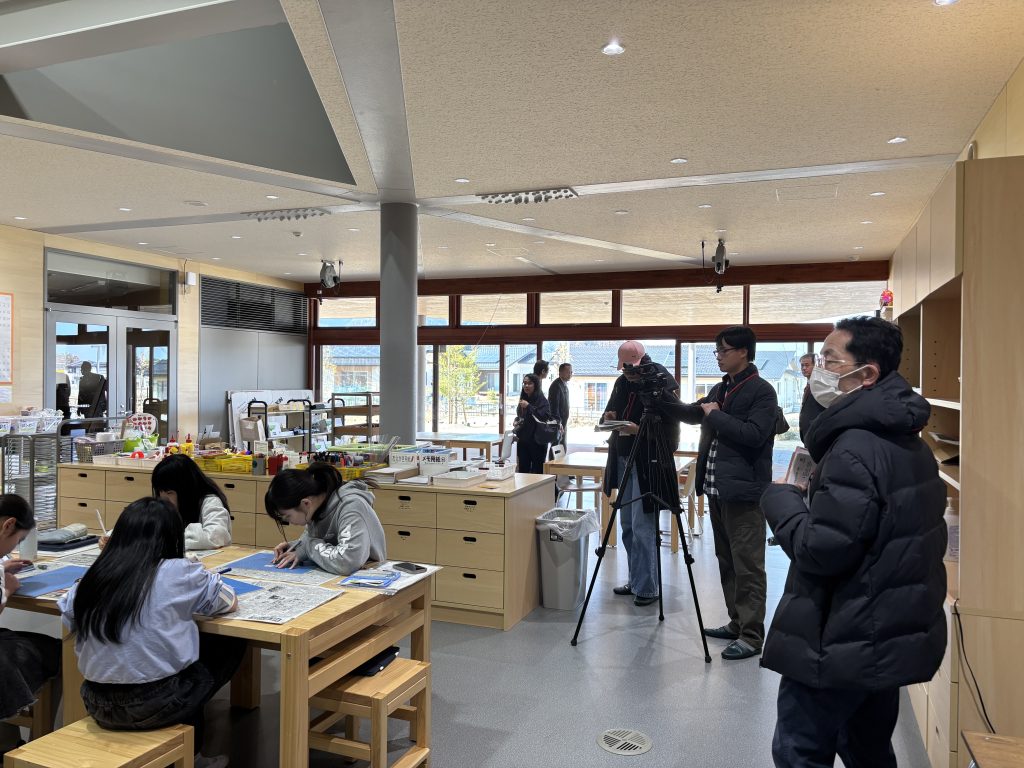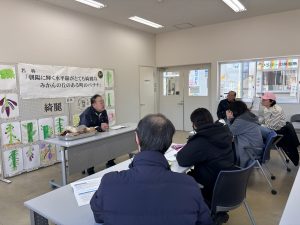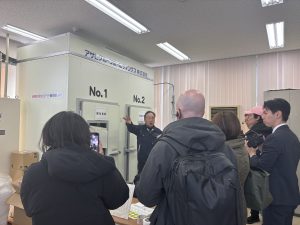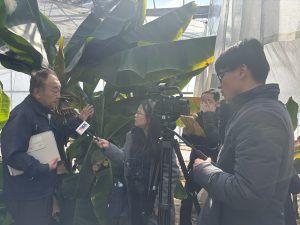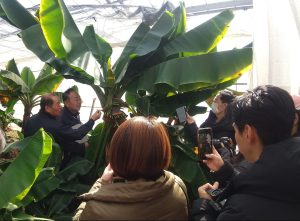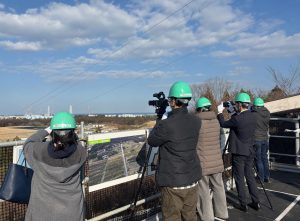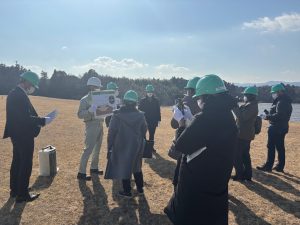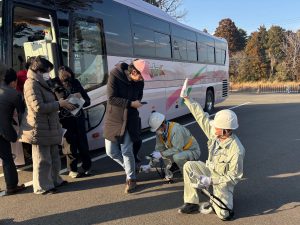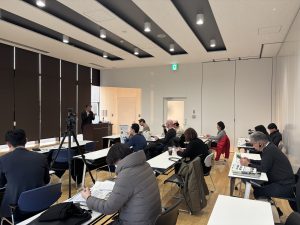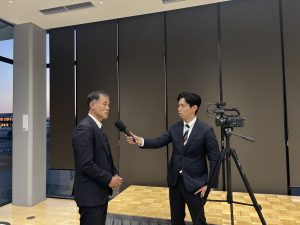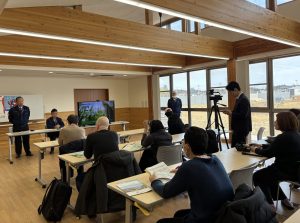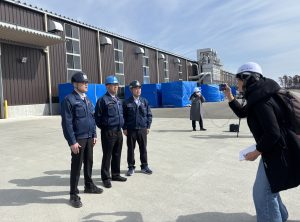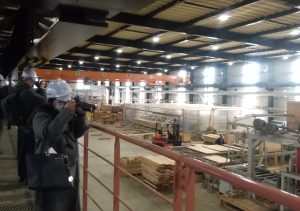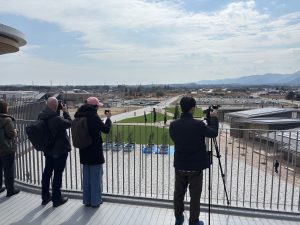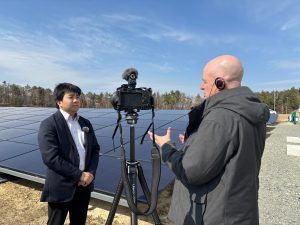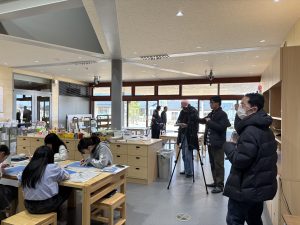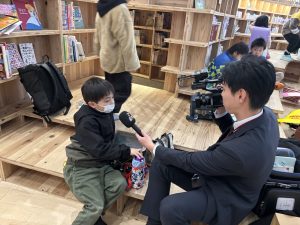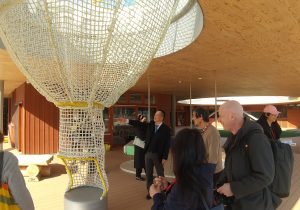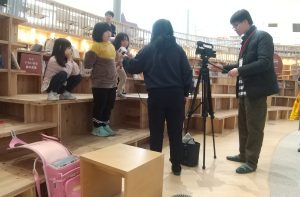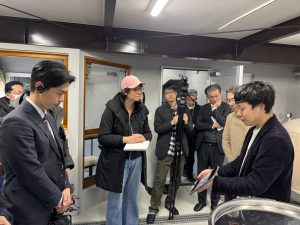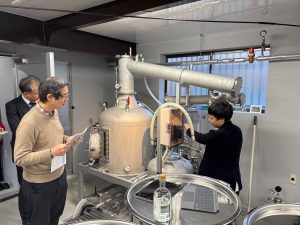実施日 : 2025年02月27日(木) - 28日(金)
Report: Fukushima Press Tour
投稿日 : 2025年03月28日
Fourteen years have passed since the Great East Japan Earthquake and the accident at the TEPCO Fukushima Daiichi Nuclear Power Station. This press tour visited Fukushima and covered environmental remediation initiatives the Ministry of the Environment carried out in Fukushima since the nuclear accident, as well as a forestry business operator, a farm, and a new resident who started a distillery, all working towards revitalizing industry; a public school attracting new residents with a unique education style where children take a proactive role; and a local government aiming to achieve zero-carbon through local use of renewable energy, without relying on power sources such as nuclear power or fossil fuels.
Nine journalists participated in the press tour, from eight media outlets based out of six countries and regions: France, South Korea, Switzerland, Taiwan, the US, and Vietnam.
*This press tour was sponsored by the Ministry of the Environment and planned/operated by the FPCJ.
*For details on the tour stops, please see the press tour announcement here.
[Day 1]
<Hirono Town Promotion Public Corporation: Cultivating Domestic Kirei Bananas (Hirono)>
The journalists visited a banana farm operated by the Hirono Town Promotion Public Corporation, which is cultivating domestic Kirei bananas with the goal of a “recovery of the heart” for disaster-affected areas. First, the tour heard from Mr. NAKATSU Hirofumi, president of the Hirono Town Promotion Public Corporation, about why they began growing bananas and their reasons for doing so, as well as about the “freeze thaw awakening method” which enables them to grow bananas in a cold climate. He also explained various initiatives to increase profitability, such as making Japanese paper (washi) using banana bark and developing processed goods in collaboration with local high school students.
Mr. Nakatsu then showed the tour to the banana farm in a greenhouse, where the journalists showed great interest in filming and photographing the banana trees with unripe banana fruits and flowers on them, a rare sight in Japan.
The journalists asked questions such as why bananas were chosen, challenges in growing bananas in the Tohoku region, and what progress there had been in a “recovery of the heart” through growing bananas, as Mr. Nakatsu had mentioned earlier.
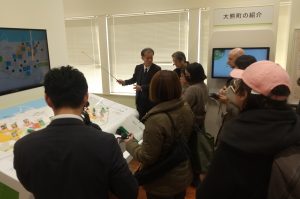 The tour visited the Interim Storage Facility, made to safely manage and store soil and radioactive waste removed as part of decontamination activities in Fukushima Prefecture until final disposal. After first receiving an explanation from Ministry of the Environment staff about the facility and what parts of it the tour would be seeing that day at the Interim Storage Facility Information Center, the tour then traveled by bus, getting off at the Soil Storage Facilities, where soil is stored after being separated from burnable material such as plant matter. The tour then visited Miwatari Shrine on the facility’s grounds, and from the bus saw the ruins of the Fukushima Prefecture Fish Farming Experimental Station, before filming and photographing Fukushima Daiichi Nuclear Power Station from approximately 2 km away, on a temporary observation deck built alongside Sunlight Okuma, a nursing home left in the condition it has been since the disaster. Finally, the tour saw the road embankment demonstration project using removed soil as recycled materials.
The tour visited the Interim Storage Facility, made to safely manage and store soil and radioactive waste removed as part of decontamination activities in Fukushima Prefecture until final disposal. After first receiving an explanation from Ministry of the Environment staff about the facility and what parts of it the tour would be seeing that day at the Interim Storage Facility Information Center, the tour then traveled by bus, getting off at the Soil Storage Facilities, where soil is stored after being separated from burnable material such as plant matter. The tour then visited Miwatari Shrine on the facility’s grounds, and from the bus saw the ruins of the Fukushima Prefecture Fish Farming Experimental Station, before filming and photographing Fukushima Daiichi Nuclear Power Station from approximately 2 km away, on a temporary observation deck built alongside Sunlight Okuma, a nursing home left in the condition it has been since the disaster. Finally, the tour saw the road embankment demonstration project using removed soil as recycled materials.
The journalists asked questions about how radiation levels were monitored, safety management for staff, how the ministry is responding to residents who wish to return, and how the soil stored in the Interim Storage Facility was managed.
<Ministry of the Environment Briefing>
Ministry of the Environment staff explained the current state of decontamination and environmental restoration, initiatives for managed recycling of removed soil, and the roadmap for final disposal of the removed soil outside of Fukushima Prefecture.
The journalists asked about the feasibility of the government’s plan of final disposal of the removed soil outside of Fukushima Prefecture by 2045, what concrete methods there were for disposal, and about managed recycling of the removed soil.
[Day 2]
<Woodcore Corporation (Namie)>
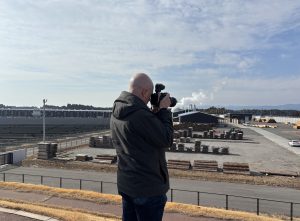 The tour visited Woodcore Corporation, which was established in 2018 with the goal of creating jobs and revitalizing the forestry industry in Namie. First, the tour heard from Woodcore’s president Mr. KAGEYAMA Toshikazu and board director Mr. ASADA Hidehiro about what led to establishing the company, their desire to revitalize Namie’s forestry industry and progress towards that goal, the manufacturing process and uses of the large laminated timber the company makes, and the high output, high frequency press which the company was the first in Japan to adopt. Led by Mr. Asada, the tour then visited the Fukushima Advanced Manufacturing Center For Laminated Timber (FLAM) where the high output, high frequency press is located, and saw the production line which could rapidly mass produce large laminated timber, for uses such as at the venue for Expo 2025 Osaka, Kansai, Japan. The journalists listened intently as both Mr. Kageyama and Mr. Asada explained how they hoped to promote Fukushima lumber to the world through the opportunity of providing approximately one third of the lumber used in the Grand Ring, the symbol of Expo 2025 Osaka, Kansai, Japan.
The tour visited Woodcore Corporation, which was established in 2018 with the goal of creating jobs and revitalizing the forestry industry in Namie. First, the tour heard from Woodcore’s president Mr. KAGEYAMA Toshikazu and board director Mr. ASADA Hidehiro about what led to establishing the company, their desire to revitalize Namie’s forestry industry and progress towards that goal, the manufacturing process and uses of the large laminated timber the company makes, and the high output, high frequency press which the company was the first in Japan to adopt. Led by Mr. Asada, the tour then visited the Fukushima Advanced Manufacturing Center For Laminated Timber (FLAM) where the high output, high frequency press is located, and saw the production line which could rapidly mass produce large laminated timber, for uses such as at the venue for Expo 2025 Osaka, Kansai, Japan. The journalists listened intently as both Mr. Kageyama and Mr. Asada explained how they hoped to promote Fukushima lumber to the world through the opportunity of providing approximately one third of the lumber used in the Grand Ring, the symbol of Expo 2025 Osaka, Kansai, Japan.
The journalists asked questions about the current state and revitalization of the forestry industry in Fukushima Prefecture, as well as questions about the lumber provided for the Expo venue, such as the possibility of it being reused and what kind of lumber was used in the Grand Ring.
<Okuma Zero Carbon Initiatives (Okuma)>
The journalists visited Okuma Town, the town that experienced a full evacuation after the accident at the TEPCO Fukushima Daiichi Nuclear Power Station and is now aiming to achieve net zero emissions of carbon dioxide ten years earlier than the Japanese national government’s goal of 2050, and covered its innovative initiatives.
First, the tour visited CREVA Okuma, a Nearly ZEB* in Shimonogami District, a pioneering area for achieving the zero carbon target, where they heard from officials with Okuma Town’s Zero Carbon Promotion Section about the town’s various initiatives. An official whose hometown was Okuma also explained their feelings on recovery after a full evacuation. Next, the tour saw the interior of the Nearly ZEB industrial complex CREVA Okuma, receiving explanations on the building’s ventilation system using geothermal heat and sensors to detect people, its open ceiling construction, and large awnings which make it a Nearly ZEB, as well as seeing the mega solar power plant and large storage batteries at the former site of Okuma Junior High School.
The journalists asked questions about the response of residents to the zero carbon initiatives, such as whether they were encouraging people to return to the town and the reason Okuma is aiming to achieve zero carbon, and whether they thought that nuclear power would still be necessary going forward.
<*ZEB: Net Zero Energy Building. Buildings that greatly reduce the amount of energy consumed annually within the building, while also creating energy to become net zero. A Nearly ZEB uses renewable power to make its annual primary energy usage close to zero, making it nearly ZEB. >
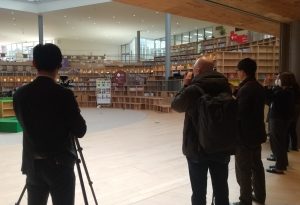 The tour visited Manabiya Yumenomori, a municipal school which opened in 2023 in Okuma with an educational philosophy respecting students’ creativity and autonomy. Vice-principal Mr. MASUKO Keishin explained the process leading to opening the school after the full evacuation of the town due to the Great East Japan Earthquake and nuclear accident, and the school’s educational policy. Afterwards, the journalists saw the building, which was designed throughout to be a fun place for children to learn while respecting their autonomy, watched classes and the “end meeting,” and interviewed the students.
The tour visited Manabiya Yumenomori, a municipal school which opened in 2023 in Okuma with an educational philosophy respecting students’ creativity and autonomy. Vice-principal Mr. MASUKO Keishin explained the process leading to opening the school after the full evacuation of the town due to the Great East Japan Earthquake and nuclear accident, and the school’s educational policy. Afterwards, the journalists saw the building, which was designed throughout to be a fun place for children to learn while respecting their autonomy, watched classes and the “end meeting,” and interviewed the students.
In addition to questions about running the school, such as how many students it could accept and what class fees were, there were also questions about relocating for the sake of education, which many people have done in pursuit of the school’s unique education system. The journalists also asked students about whether they liked the school and what they liked learning about. Later, a journalist mentioned how the students seemed to be very active and having fun.
<naturadistill Kawauchi Distillery (Kawauchi)>
The tour visited naturadistill Kawauchi Distillery, which makes gin using the underground water from Kawauchi and plants mainly from Fukushima Prefecture, and heard from Mr. OSHIMA Sota, a co-founder of the distillery, about why they made a distillery in Kawauchi, why he moved to Kawauchi from Tochigi Prefecture, and his passion for making craft gin. Mr. Oshima, who heard cruel comments about Fukushima when he lived overseas, said that experience made him feel strongly that he had to promote the appeal of Fukushima people around the world, and explained the distillery’s future plans. After a detailed description of how gin is made and what points in the distillation process they pay careful attention to, the journalists were able to sample the aroma and taste of the first gin made in the distillery.
The journalists asked questions such as why they chose gin of all the different liquors available, what makes a gin taste good, whether the fruits and plants used in the gin were locally grown in Fukushima Prefecture, and about the gin boom in Japan.
◆Below are some of the reports based on this tour.
Korea JoongAng Daily(Korea)
“후쿠시마 원전사태 14년…"바나나꽃이 활짝 피었습니다" [출처:중앙일보]” (March 10, 2025)
Taiwan Public Television Service(Taiwan)
“福島核災污土等同11座東京巨蛋 2045年前需移出、選址未定案” (March 10, 2025)
“福島核災後林木業者另起爐灶 生產高品質木材投入大阪世博” (March 11, 2025)

